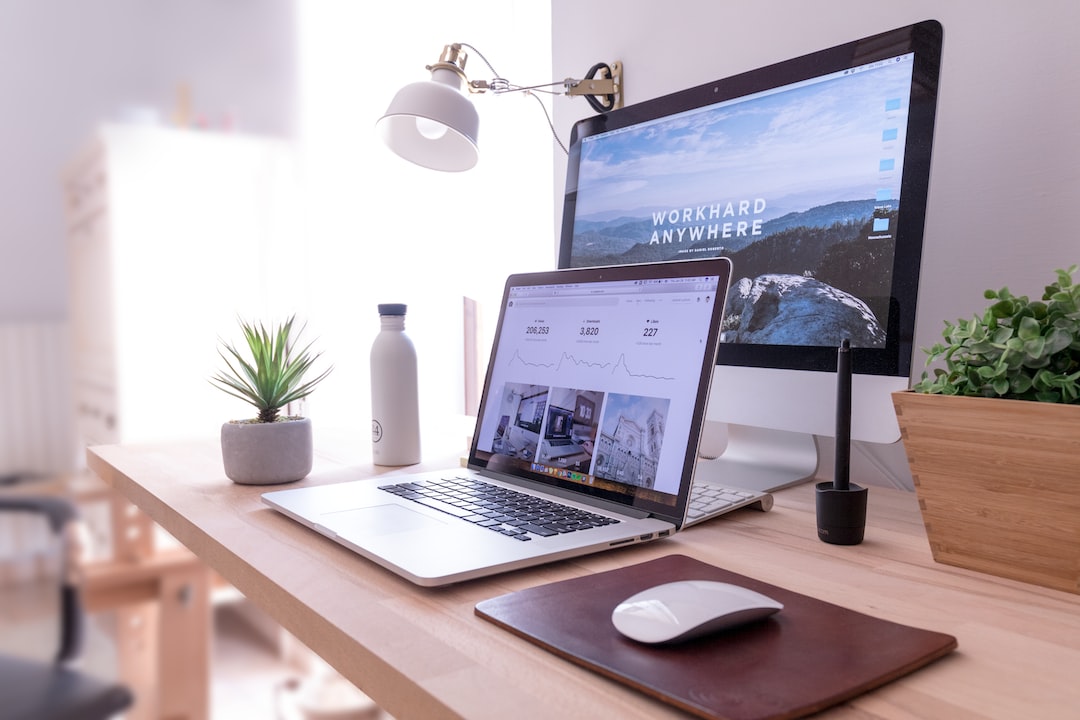In today’s digital age, having a visually appealing website is crucial for businesses and individuals alike. Visual design plays a significant role in creating a positive user experience and engaging visitors. It is the first impression that users have of a website, and it can make or break their decision to stay and explore further. A well-designed website not only captures attention but also communicates the brand’s message effectively.
Minimalist Designs: Less is More
Minimalist design is a popular trend in website design that focuses on simplicity and clean aesthetics. It involves using minimal elements, such as white space, simple typography, and limited color palettes, to create a visually pleasing and clutter-free website. The advantage of using minimalist design is that it allows the content to take center stage, making it easier for users to navigate and find what they are looking for.
One example of a website with a minimalist design is Apple’s homepage. The use of white space, minimal text, and high-quality product images creates a sleek and modern look. Another example is the website for the Museum of Modern Art (MoMA). The use of clean lines, simple typography, and limited color palette allows the artwork to shine and creates a sense of sophistication.
Bold and Colorful: Making a Statement with Vibrant Hues
Color plays a crucial role in website design as it can evoke emotions, convey messages, and create visual interest. Using bold and vibrant colors can make a statement and grab the attention of users. However, it is important to use colors strategically to avoid overwhelming the user or creating a chaotic design.
One example of a website that effectively uses bold and colorful design is Spotify. The use of vibrant hues creates a fun and energetic vibe that aligns with the brand’s identity as a music streaming platform. Another example is Airbnb’s website, which uses bright colors to highlight different destinations and create a sense of excitement and adventure.
Interactive Elements: Engaging Your Audience with User-Experience
Interactive design involves creating elements on a website that engage and interact with the user. This can include features such as sliders, animations, hover effects, and scroll-triggered animations. Interactive elements not only make the website more engaging but also improve the user experience by providing feedback and guiding the user through the content.
One example of a website with interactive elements is Nike’s website. The use of hover effects and animations creates an immersive experience that showcases their products in an engaging way. Another example is the website for The New York Times, which uses scroll-triggered animations to reveal content and create a dynamic reading experience.
Parallax Scrolling: Creating Depth and Movement on Your Website
Parallax scrolling is a technique in website design that creates an illusion of depth and movement by having different layers of content move at different speeds as the user scrolls. This adds a dynamic and interactive element to the website, making it more visually interesting and engaging.
One example of a website that effectively uses parallax scrolling is the website for Oakley. As the user scrolls, different layers of content move at different speeds, creating a sense of depth and movement that enhances the storytelling aspect of the website. Another example is the website for Peugeot Hybrid4, which uses parallax scrolling to showcase their hybrid technology in an interactive and visually appealing way.
Typography: Choosing the Right Fonts to Make Your Content Pop

Typography plays a crucial role in website design as it not only conveys information but also sets the tone and personality of the brand. Choosing the right fonts can make your content stand out and create a visually appealing design.
When choosing fonts for your website, it is important to consider readability, hierarchy, and consistency. Fonts should be easy to read on different devices and screen sizes. Hierarchy can be achieved by using different font sizes, weights, and styles to guide the user’s attention. Consistency in font choices throughout the website creates a cohesive and professional look.
One example of a website with great typography is Medium. The use of a clean and simple font for the body text, combined with a bold and distinctive font for headings, creates a visually appealing and easy-to-read design. Another example is the website for Airbnb’s magazine, which uses a combination of serif and sans-serif fonts to create a sophisticated and modern look.
Illustrations and Animations: Adding Personality and Playfulness
Illustrations and animations can add personality and playfulness to a website design. They can be used to tell a story, convey emotions, or simply add visual interest. When used effectively, illustrations and animations can create a memorable and engaging user experience.
When using illustrations and animations, it is important to consider the style, consistency, and purpose. The style should align with the brand’s identity and message. Consistency in the style of illustrations and animations throughout the website creates a cohesive look. The purpose should be to enhance the user experience and communicate information effectively.
One example of a website that effectively uses illustrations is Dropbox. The use of playful and colorful illustrations adds personality to the design and creates a friendly and approachable vibe. Another example is the website for Mailchimp, which uses animations to guide the user through the onboarding process in a fun and interactive way.
Responsive Design: Ensuring Your Website Looks Great on Any Device
Responsive design is an approach to website design that ensures the website looks great and functions properly on any device or screen size. With the increasing use of mobile devices, it is crucial for websites to be responsive to provide a seamless user experience across different devices.
Responsive design involves using flexible layouts, fluid images, and media queries to adapt the website’s layout and content based on the device’s screen size. This ensures that the website is easy to navigate, read, and interact with on any device.
One example of a website with responsive design is Starbucks. The website adapts seamlessly to different screen sizes, providing a consistent user experience whether the user is on a desktop, tablet, or mobile device. Another example is the website for The Guardian, which also adjusts its layout and content based on the device’s screen size, providing an optimal reading experience.
Experimental Designs: Pushing Boundaries and Breaking the Rules
Experimental designs are those that push the boundaries of traditional website design and break the rules to create unique and innovative experiences. While experimental designs may not be suitable for all websites, they can be a great way to stand out and make a bold statement.
When experimenting with website design, it is important to consider usability and accessibility. While pushing boundaries is encouraged, it should not come at the expense of usability or accessibility. Experimental designs should still provide a positive user experience and effectively communicate the brand’s message.
One example of a website with an experimental design is The Wilderness Downtown. This interactive music video experience uses Google Maps and personalized content to create a unique and immersive experience for each user. Another example is the website for The Boat, which uses a combination of video, animation, and interactive elements to tell a captivating story.
Using Inspiration to Create Your Own Stunning Website Design
In conclusion, visual design plays a crucial role in creating a positive user experience and engaging visitors on websites. By using different design elements such as minimalist designs, bold and colorful designs, interactive elements, parallax scrolling, typography, illustrations and animations, responsive design, and experimental designs, you can create a visually appealing and unique website that stands out from the competition.
Finding inspiration from other websites and designers can help you discover new ideas and approaches to design. However, it is important to use inspiration as a starting point and not simply copy or imitate other designs. By understanding the principles and techniques behind different design elements, you can create your own stunning website design that effectively communicates your brand’s message and engages your audience. The power of visual design in website creation cannot be underestimated, and by harnessing this power, you can create a website that leaves a lasting impression.
If you’re interested in graphic website design, you may also want to check out the article on “The Significance of Having a Website” on Ario Film’s website. This article discusses the importance of having a website for businesses and individuals alike, highlighting how it can enhance your online presence and help you reach a wider audience. It provides valuable insights and tips for creating an effective website that showcases your brand and engages visitors. To read more about it, click here.
FAQs
What is graphic website design?
Graphic website design is the process of creating visually appealing and engaging websites using various graphic design elements such as typography, color, images, and layout.
What are the benefits of graphic website design?
Graphic website design can help improve user experience, increase website traffic, and enhance brand recognition. It can also make a website more memorable and help it stand out from competitors.
What are some key elements of graphic website design?
Some key elements of graphic website design include typography, color, images, layout, and user interface design. These elements work together to create a cohesive and visually appealing website.
What are some popular tools used in graphic website design?
Some popular tools used in graphic website design include Adobe Photoshop, Adobe Illustrator, Sketch, Figma, and Canva. These tools allow designers to create and manipulate graphics, images, and other design elements.
What are some best practices for graphic website design?
Some best practices for graphic website design include using a consistent color scheme, choosing legible fonts, optimizing images for web use, and designing with mobile devices in mind. It’s also important to prioritize user experience and make sure the website is easy to navigate.

